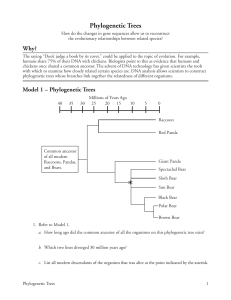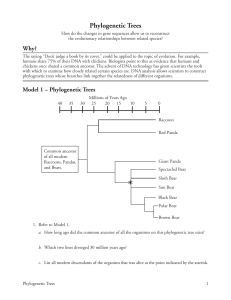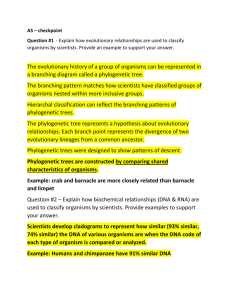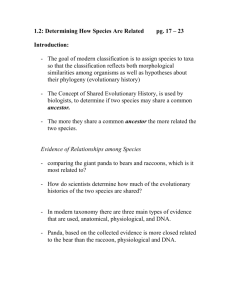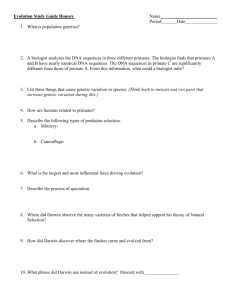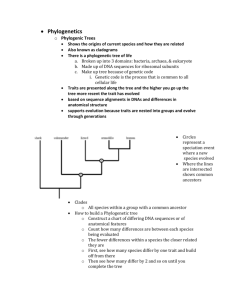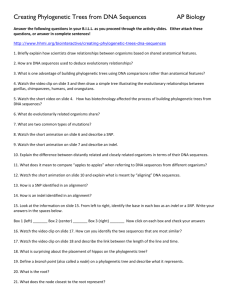Phylogenetic Trees & DNA: Evolution Worksheet
advertisement
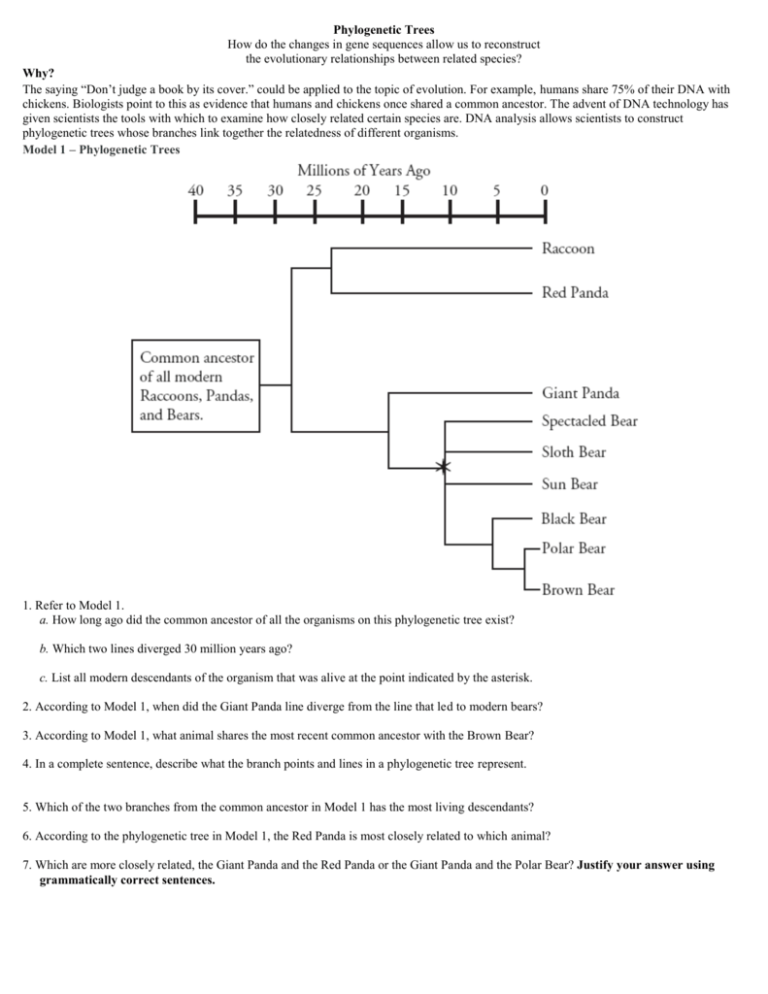
Phylogenetic Trees How do the changes in gene sequences allow us to reconstruct the evolutionary relationships between related species? Why? The saying “Don’t judge a book by its cover.” could be applied to the topic of evolution. For example, humans share 75% of their DNA with chickens. Biologists point to this as evidence that humans and chickens once shared a common ancestor. The advent of DNA technology has given scientists the tools with which to examine how closely related certain species are. DNA analysis allows scientists to construct phylogenetic trees whose branches link together the relatedness of different organisms. Model 1 – Phylogenetic Trees 1. Refer to Model 1. a. How long ago did the common ancestor of all the organisms on this phylogenetic tree exist? b. Which two lines diverged 30 million years ago? c. List all modern descendants of the organism that was alive at the point indicated by the asterisk. 2. According to Model 1, when did the Giant Panda line diverge from the line that led to modern bears? 3. According to Model 1, what animal shares the most recent common ancestor with the Brown Bear? 4. In a complete sentence, describe what the branch points and lines in a phylogenetic tree represent. 5. Which of the two branches from the common ancestor in Model 1 has the most living descendants? 6. According to the phylogenetic tree in Model 1, the Red Panda is most closely related to which animal? 7. Which are more closely related, the Giant Panda and the Red Panda or the Giant Panda and the Polar Bear? Justify your answer using grammatically correct sentences. Model 2 – DNA Sample Comparison 8. How many bases are found in each of the DNA samples 1–4 as well as in the DNA from organism A in Model 2? 9. Using your knowledge of base-pairing, which DNA sample in Model 2 will be 100% complementary to organism A? 10. Which other DNA sample in Model 2 is likely to pair with one of the strands from organism A? 11. How many of the total number of base pairs in the sample you chose in Question 10 are noncomplementary between the strands? 12. From your answer to Question 11, convert the number of noncomplementary pairs into a percentage of the total base-pairs. This is called the sequence divergence. 13. Calculate the sequence divergence for the remaining two samples. Check your calculations within your group. 14. Use the calculations from the previous questions to fill in the table below. Most Homologous Sample 3 Sequence Divergence 0% Least Homologous 15. Based on your previous knowledge of DNA, which sample from Model 2 is from an organism that is most closely related to Organism A? 16. With your group, describe how DNA sequence divergence can give scientists information about relatedness. 17. Fill in the phylogenetic tree below with Samples 1 through 4 to summarize the relatedness of the organisms that supplied the samples. Model 3 – Comparing the Cytochrome c Gene *No amino acid at this position 18. Cytochrome c is a protein used in cellular respiration in many species. Refer to Model 3 to answer the following questions about cytochrome c. a. How many different species are represented in the cytochrome c amino acid sequences? b. What do the individual letters represent? c. What do the asterisks represent? 19. Circle the pairing of organisms from Model 3 that you predict would have the most divergence in their DNA. Support your choices with a group discussion about morphology (observable characteristics and structure), ecology, and lifestyles of the animals. a. whale and human or whale and tuna b. pig and rhesus monkey or pig and chicken c. tuna and fly or tuna and chicken Read This! Cytochrome c is a protein that is shared by many organisms due to its vital role in cellular respiration. Over time (billions of years) mutations have occurred in the cytochrome c gene that do not affect the function of the cytochrome c protein. These mutations are called neutral mutations. By looking at these mutations scientists can predict when the organisms diverged from a common ancestor and from each other. 20. Refer to Model 3. Write down the number of differences between the amino acid sequence of cytochrome c in a human and each of the following organisms. a. Tuna ____ e. Pig ____ b. Whale ____ f. Yeast ____ c. Rhesus monkey ____ g. Fly ____ d. Chicken ____ 21. Based on the differences in amino acid sequences, to which organism from the list are humans a. Most closely related to? b. Most distantly related to? 22. Enter the names of the seven organisms in Model 3 into the tree below, to illustrate a phylogenetic relationship between these organisms and humans, as suggested by the cytochrome c data. 23. How do your predictions about relatedness based on morphology, ecology, and lifestyle in Question 19 compare to the relatedness information in the phylogenetic tree developed from DNA data in Question 22? 24. Circle all of the mammals in the phylogenetic tree in Question 22. How does the tree illustrate the fact that those animals are all members of the same class? 25. Compare the differences in amino acid sequences among the mammals with differences in other animal classes. Is there a pattern? 26. Should scientists infer evolutionary relationships based on data from a single protein? Justify your answer in complete sentences. Extension Questions Read This! Scientists have found that neutral mutations like those found in cytochrome c occur at a fairly steady rate throughout evolutionary history. For this reason, neutral mutations are used to measure the time that has passed since two species have diverged through evolution. The rate of mutation must be calibrated with samples where the actual time of species divergence is known from fossil records. In other words, scientists have developed a molecular clock that can be used to estimate the divergence time between organisms. 27. Plot the percentage sequence divergence on the y-axis and the known age of common ancestor on the x-axis for the following species pairs. 28. Draw the trend line for the points you have plotted. Using the trend line, calculate the slope of the line that describes the relationship between sequence divergence and known age. Give a value as % divergence/million years. This is the calibration value for this molecular clock. 29. At the same gene the sequence divergence between chimpanzees and bonobos is 4.2%. Using the calibrated molecular clock estimate the time at which these species diverged. 30. The sequence divergence between humans and Neanderthals at the same gene is 1.2%. Using the calibrated molecular clock, estimate the time these species diverged.
